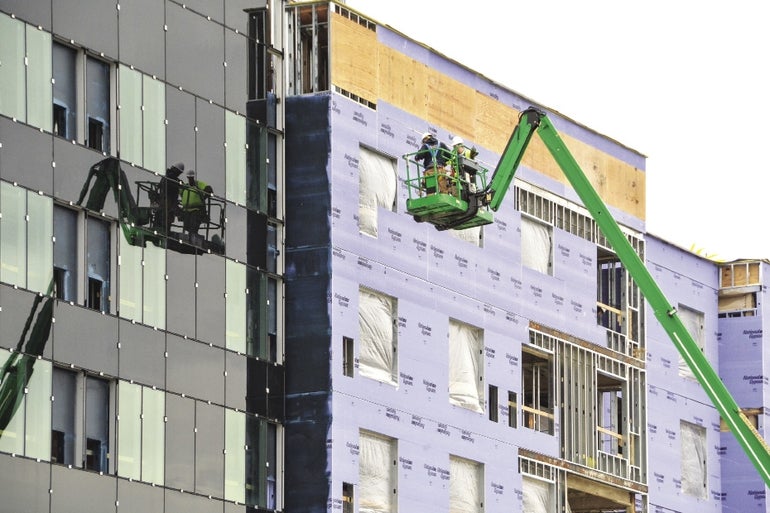If home prices are spiking because of low supply and high demand, construction firms seemingly can take advantage of a large market opportunity by ramping up their new home construction.
If it were only that simple.
With the Massachusetts unemployment rate at just 3.6 percent in July, construction firms simply can’t find enough workers. Nowhere is the shortage more severe than in Massachusetts.
Around 43 percent of construction jobs posted last year in Massachusetts remained unfilled after 45 days, according to BuildZoom, a website helping people find contractors. The national average was just 39 percent.
The number of construction workers in Massachusetts shrunk by 7 percent from 2005 to 2016, BuildZoom reported, while the overall Massachusetts workforce grew by nearly 8 percent during that time, according to Bureau of Labor Statistics data.
“The No. 1 reason was the recession,” said Paul Emrath, an economist for the Washington-based National Association of Home Builders. “It discouraged people and scared them away.”
During the Great Recession, workers in the construction industry were among the hardest hit, as capital dried up for new construction projects and firms were forced to cut costs. Construction is among the last industries yet to recover its employment levels from prior to the Great Recession.
“It’s hard to track where they went and exactly why they’re not coming back,” Emrath added.
Whatever the reason, Massachusetts has potentially suffered the most.
Issi Romam, an economist who wrote the BuildZoom report and a fellow at the University of California Berkeley, said in Massachusetts and particularly the Boston area the effect is also the cause: fewer people may be going into construction work in high-priced areas where labor markets are already tight because they may seek higher-earning work.
High prices in and around Boston in particular are, in part, due to a longterm trend of not building enough homes, Romam said. “It’s been decades in the making,” he said.
Smaller, older workforce
Construction-industry leaders are working to pitch the field to prospective workers by mentioning its relatively high pay without needing a college degree. Construction workers in Greater Worcester make $48,930 a year on average, according to the Bureau of Labor Statistics.
Officials also work to publicize areas where wages are higher, or show higher-ups in the field almost always have a background in the trades, indicating workers have a pathway toward more responsibility and better pay.
But worker shortages have only worsened in the past year, according to the National Association of Home Builders. Worker gaps are most severe for carpenters and framing crews but are also severe for electricians and roofers. The gap is widest for subcontractors, who aren’t as likely to show up in commonly cited labor statistics as no longer working in the field, Emrath said.
Construction relies on immigrant labor, a factor Emrath and Romam said can’t be relied upon in today’s political climate.
It also isn’t just a matter of workers who’ve left. According to BuildZoom, the share of construction workers who are under 25 has shrunk nationwide since 2000. In Massachusetts, those youngest workers made up 12.4 percent of the field in 2005. Now, it’s 9.9 percent.
“It’s a very difficult problem attracting people to manual labor, to blue collar work, these days,” Romam said.
The Massachusetts Building Trades Council, which represents more than 75,000 workers, has not had to curtail any construction projects because of worker shortages but has noticed a difficulty in more recent years as construction activity has remained high, said Frank Callahan, the council’s president.
“It’s becoming more difficult, but we haven’t reached a situation where we haven’t been able to staff a job,” Callahan said.
Another union labor leader, Worcester-Fitchburg Building Trades Council President Brian Brousseau, said his members have been able to meet demand. He portrayed the shortage as one stemming from less-attractive non-union positions.
“It’s not surprising that people don’t want to do dangerous non-union work for sub-par compensation, especially given the millions of dollars in wage theft that occurs on non-union construction sites,” Brousseau said. “If builders or contractors are struggling to find workers, they should call us.”
No workers, no construction
The Federal Reserve Bank of Kansas City estimated last year a gap of 6.9 million homes between what has been built for new homes since 2000 and what should have been, based on the needs of a growing population. That gap represents 5.8 percent of the national housing stock, the report said.
Increasing sale prices and rents will likely spur further growth in the short term, the Kansas City Fed said.
“But,” it added in its report, “the level of home construction is likely to remain low by historical benchmarks.”
With fewer workers, there has simply been less ability to build new homes.
In Worcester County, the past decade has seen less than half of the new-home construction compared to just before the recession, according to Census data.
Because of low supply and high demand, the price of a single-family home in Worcester County hit $307,000 in June, a record high and an 11-percent increase over the previous year, according to Boston real estate date firm The Warren Group.
Nationwide, the story is much the same. During the Great Recession, construction of new houses as a share of U.S. households hit its lowest level since recordkeeping began in 1957 and has barely increased since, according to the Kansas City Fed report.
The nation built more than 1 million new homes each year from the end of World War II until 2007, Emrath said. Then, for six straight years, the nation fell short of that amount.
“Everything is on the upward trend in order of things only getting worse,” Emrath said.

